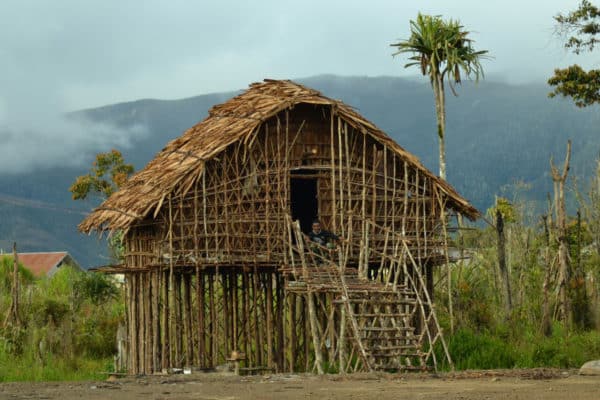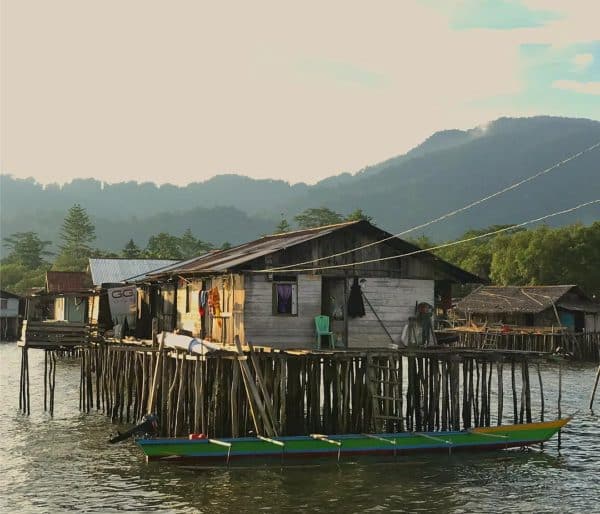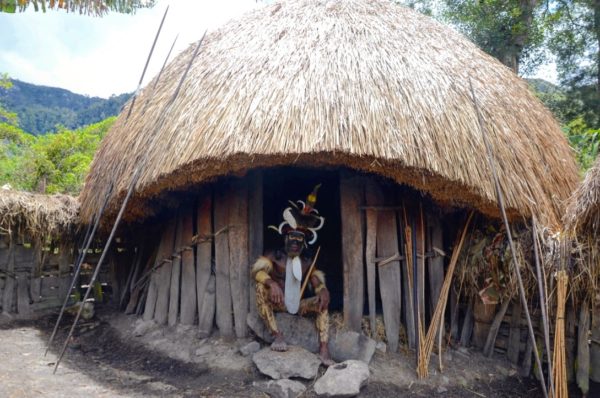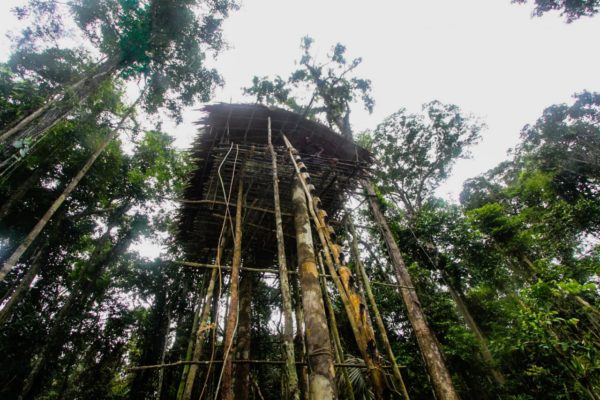For the first time I set foot in the Arfak Mountains, I was greeted by beautiful views of the Anggi lakes. I was amazed that people could live here. It was so cold and they live so remote and so far from everything that I know. I, along with several relatives, arrived at our destination high in the Arfak Mountains which is almost on 2000M. altitude. We went there to attend the celebration on the entry of the gospel. We stayed there a few days.
On our first night, we were invited to stay in a modern concrete house that was built by the government. Throughout the night I could not sleep well. I was wearing thick clothes and had a warm blanket but I was still very, very cold. The next day we followed the event. We worshipped, ate together and watched a number of traditional dance offerings. In the evening a family invited us to stay in their local house. The traditional Millipedes.
Their house was built using many poles with an average height of 4-5 meters and arranged with a distance of approximately 30 centimetres between the pillars. Their home was so unique and so different than my home. With the many legs carrying it, I hoped it didn’t ran away . Their house only has two doors. One in the front and one in the back, while it does not have any windows. The family explained to me that the house was built high to protect them from wild animals, like wild pigs. To keep themselves warm they make a fire inside the house, where they also cook.
Because the house had no rooms, the family slept on the right side and we slept on the left side. The fire kept me warm and just before I fell asleep I heard something underneath the house. I imagined a wild pig looking for some fresh city meat. I got scared, took my flashlight and pointed it into the wooden cracks to find out it was only a dog looking for warmth, just like me. With an ease heart I fell asleep and slept like a baby!

It was my first experience of sleeping in a traditional house in Papua! It was such a great experience and I have decided that I want to explore more of them. The traditional houses that you can find here come from ancient times. Many of them have such an unique shape. In Wamena they are shaped like giant mushrooms. In Arfak with many legs and in Korowai high in the trees! This year, in 2019 I want to visit and stay in the following houses:
Floating House / Rumah Balabu
This traditional house can be found on the coast or lake sides. For example in Sentani lakes. I have seen these houses before, when I was in Jayapura, but I only saw it from a distance. As I know these houses are built on the surface of the water and do not have rooms. We call them ‘Rumah Balabu’, Floating House. Because it looks like they are floating on water. The houses are made of wood, the roof is made of coconut leaves and the walls and floors aremade of areca nut trees. Modern ‘Rumah Balabu’ nowadays are made of zinc while the walls and floors are made of boards. The houses are built on water so many wooden bridges are made to connect one house to the other. Like a road over water! Most of the residents of these houses are those who live on the coast and make a living on fishing (fishermen). Many of them are in the areas of Biak, Serui, Nabire and Asmat.

Honai
Honai is the name for the traditional house of the Dani tribe in Wamena. The shape resembles a mushroom, with a dome-shaped roof and circular walls. The roof of a Honai is made of grass which is arranged to make it rain-proof. The walls are made of wood. A Honai was intentionally made only to have one door and no window to keep it warm inside. Because also in Wamena it can get very cold. One Honai can support 5-10 people. The Honai has four support poles in the middle and a fireplace inside to keep themselves warm and to cook. The floor is usually just the earth covered with dried grass. The men and women live in separate areas of the Honai. Usually the men sleep circled around in the ground floor, with the head in the middle and foot on the edge outside, likewise the women sleep on the first floor. The women and children live in the same Honai, but if her boys grow up they move into their father’s Honai. The ground floor and the first floor are connected with a ladder from bamboo. A family has 3 different buildings according to functions. One Honai is a resting place (to sleep in), the second is where they eat together and the third is for the livestock, mainly pigs. I’m really curios about this famous traditional house. I only know these houses from stories of friends.

Tree Houses
The first time that I knew about this kind of house is from the cartoon, Marsupilami. This comic character makes his house high in the trees. I was amazed to found out that we in Papua have tree houses too! The Tree House is a traditional house from the Korowai tribe. As the name suggests, the house is made in a tree that can reach up to 50 meters from the ground! They make stairs using trunk. The Korowai tribe lives in the lowland jungle and they are nomads. They makes their houses high in the trees to avoid wild animal attacks and before, to be safe from tribal wars. Tree houses are made from natural materials found in the middle of their forest such as trees, branches, tree trunks, tree roots, rattan and leaves. They cook, sleep and work in their tree house. They only go down to hunt, to make sago and collect raw materials that can be processed into food or other equipment (clothes, work tools, etc.). I am really curious to see the tree houses in real life and this one is definitely on my top list for 2019

Dijem sijo,
Love